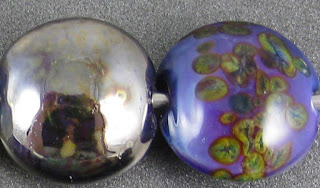Reichenbach Purple Rose (RL2202) is an almost shockingly vibrant purple. It's a very, very soft colour and it boils and pits really easily if you repeatedly heat and cool it while working it. It seems best, when using this colour, to apply it, quickly shape whatever you're working on, and then get it in the kiln as quickly as possible with minimal reheating.
This colour is very, very reactive. Because of this colour's super softness and because of its dramatic, black reaction with Ivory, I want to guess that this colour contains lead. It is pretty common for pinks and purples to contain lead, and you can only be sure that there is no lead if it does not do this to Ivory. Some other colours that react similarly include Effetre EDP, Effetre Sedona, Effetre Rubino Oro, CiM Cranberry, Reichenbach Opal Raspberry, and Reichenbach Flamingo.
In the self-coloured spacers above, you can see that Purple Rose can have a lot of colour variation. The spacer on the left contains a lighter bright purple as well as a dark purple blushing. Reducing Purple Rose brings the metals to the surface and makes it a shiny, duller greyish purple.
Purple Rose is tremendously reactive with Silver. In the bead on the left, my silver turned a bizarre blend of mustardy colours. When this reaction is reduced and encased, it is paler yellow and has really interesting texture under the clear.
Purple Rose makes Copper Green separate pretty dramatically into dark and light turquoise. When the Purple Rose is used on top of Copper Green, it makes the Copper Green float into broad halos around it, giving it a sort of cellular look. Copper Green does not develop its customary metallic sheen when used with Purple Rose.
Purple Rose also reacts really dramatically with Opal Yellow. In the leftmost bead here, you can see that the Opal Yellow has blushed a deep yellow around the edges of the separated dots and stringer lines. This is remarkable because Opal Yellow almost never looks truly yellow. It's usually the colour of butter, and can sometimes turn pink, but I think this is the only time I've ever seen it go bright yellow. On top of Opal Yellow, Purple Rose looks more pink than purple.
Purple Rose turns Ivory into a black mess. In the bead on the right, the Purple Rose looks almost crumpled with dark blotchiness.
Peace separates on top of Purple Rose. On top of Peace, Purple Rose spreads slightly and looks a little translucent in places.
Here are some beads that I made with Purple Rose. I didn't have a lot of this colour, so I didn't get to have as much fun with it as I might have liked.
This goddess bead was etched because of the serious amount of devitrification, boiling, and pitting this colour did on me. You can see the really fun variations in purple that you can get with a single rod of Purple Rose.



























